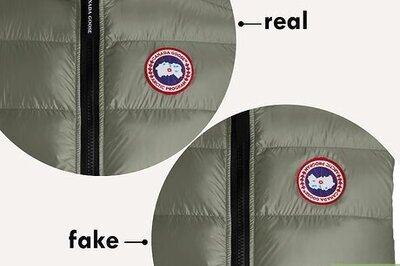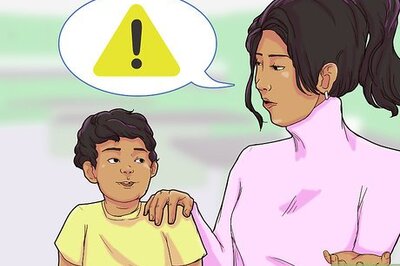
views
Using a Utility Knife
Measure and mark where you want to cut. Lay the Hardie board flat on the floor or on a sturdy work surface. Use a ruler or another straightedge to measure the size of the backer board or siding you need. Draw the line directly on the backing board with a pencil. Always double-check your measurements before you cut the Hardie board so you don’t make any mistakes. Some Hardie backer boards have pre-measured grid lines you can use so you don’t have to measure or mark your board.
Cut into the line with a utility knife or scoring knife. While a carbide scoring knife is the most durable, a utility knife blade works well too. Align your straightedge with the line you’re cutting and hold it in place. Apply firm pressure as you pull the knife blade along the line. Cut along the line 3-4 times to score the material. Keep extra utility knife blades handy in case the one you’re using starts to dull. Scoring usually works best on Hardie boards and siding that are ⁄4 in (0.64 cm) thick or thinner. If you’re working with a thicker material, then try another cutting method.
Pull the Hardie board up to snap apart the pieces. Lay the Hardie board on the floor and kneel on the side you’re not using. Press your hand down at the top of the line. Use your other hand to grab the edge of the board, and pull it straight up until the pieces snap apart. If the Hardie board doesn’t bend or snap easily, try scoring the line a few more times so it’s easier. If you’re having trouble lifting and snapping the board, ask a friend to help you out.
Shave off excess material with the knife blade. The Hardie board may have rough edges after you snap it apart, so run your knife blade along the edges. Trim off any raised areas or frayed edges so the board has a nice, clean edge when you’re finished.
Using an Angle Grinder
Work outside where it’s well-ventilated. Using power tools to cut Hardie board can create a lot of harmful silica dust that can lead to lung problems if you breathe it in. Set up a work bench or a couple of saw horses in your garage or yard so there isn’t as much dust buildup. If you aren’t able to work outside for some reason, remove anything you can from the room and cover leftover items with plastic sheeting for an added layer of protection.
Install a diamond cutting wheel onto your angle grinder. Diamond cutting wheels are made for cutting through cement, so they work well for Hardie boards made from cement fiber. Unscrew the old cutting blade from your angle grinder and pull it off the tool. Place the diamond blade onto the tool and tighten it so it’s completely secure. You may have to press a locking button or use a special tool that came with your angle grinder to remove the cutting wheel. Check the manual for the specific angle grinder you have for any special instructions.
Wear safety goggles and a HEPA respirator. Because an angle grinder creates a lot of harmful silica dust, wear eye protection so particles don’t get in your eyes. Then, put on a filtered respirator mask so you don’t breathe in dust through your mouth or nose. While it’s not required, you may also wear disposable coveralls to keep dust off of your clothes.
Measure and mark the area you’re cutting. Use a ruler or straightedge to measure the dimensions you need, and draw the cut lines on the Hardie board with a pencil. Angle grinders work for any type of Hardie board, but they’re best for smaller, shorter cuts. If you’re cutting out large pieces, then another cutting method will give you more precision.
Cut along the lines with your angle grinder. To use the angle grinder, hold it firmly with both hands so you have the most support. Turn the angle grinder on and let it spin at full speed. Then, slowly press the cutting wheel into the Hardie board along the line. Slowly push the angle grinder through the material until you cut the piece out completely. Avoid forcing the angle grinder through the material quickly because you could damage the Hardie board or the cutting wheel.
Cutting Large Hardie Board Pieces with a Saw
Work outdoors or in a well-ventilated space. Hardie boards are made of cement-fiber so they create harmful silica dust when you cut through them with power tools. Place a couple of saw horses outside to rest the boards on while you’re cutting them. Avoid using power saws indoors because the dust can get stuck on your items and easily become airborne again.
Use a saw blade made for cutting through fiber-cement. A circular saw or jigsaw work best for cutting through Hardie board because they’re quick and precise. If you’re using a circular saw, install a carbide-tipped blade onto the machine that’s made for cutting through cement. For a jigsaw, choose a diamond-grit blade that grinds through masonry. Avoid using standard wood-cutting blades because the Hardie board will make them dull
Mark the line you’re cutting with a straightedge. Measure how much Hardie board you need for your project and transfer the measurements onto the board. Use a straightedge to draw a straight cutting line across the board or siding. Leave your straightedge on the Hardie board to use as a cutting guide for your saw blade.
Put on a respirator and safety goggles. To protect yourself from the dust, put on a pair of safety goggles that completely cover your eyes. Then, put on a respirator that covers your nose and mouth and has a HEPA filter so the dust doesn’t get into your lungs.
Cut along the line with your saw. Align the saw’s blade with the line you drew and turn it on. Once the saw is running at full speed, slowly push it through the Hardie board and follow along the cut line. Continue guiding the saw through the material until the pieces are fully cut out. Using a saw leaves a smooth finished edge so you won’t have to clean up or remove excess material.
Using Cement Snapper Shears
Mark the line you want to cut on the Hardie board. Measure the length of Hardie backer board or siding that you need. Then, draw a line on your material using a straightedge. Double-check your measurements before making any cuts to ensure your pieces are the right size.
Guide cement shears along the cutting line. Get cement snapper shears or use a shears attachment for a drill. Line the cutting blades up with the line you drew on your Hardie board and turn on the tool. Slowly push the shears along the line to cut out the pieces without creating any dust.
Cutting Circular Holes in Hardie Board
Trace or draw the circle onto your Hardie board. Hold the circular piece you need to cut out against the Hardie board and trace around it with a pencil. If you’re not able to trace the circle, measure the size you need and draw it on the surface with a compass.
Draw lines through the circle. Make a straight vertical line through the center of the circle so it’s split in half. Then, add a horizontal line through the center. Make an X through the middle of the circle so the cut lines resemble a sliced pizza.
Score along the lines with a scoring knife or utility knife. Apply firm pressure as you carefully follow along the outlines of the circle with the knife blade. Make sure to score all of the straight lines going through the circle as well to help weaken the material so it’s easier to remove. Go over the lines 3-4 times so the scores are deep in the material and easier to break.
Tap around the edge of the circle with a hammer. Lightly hit the front of the Hardie board with your hammer around the circle’s outline. Then, gently tap along the straight intersecting lines to loosen the pieces.
Break the pieces out from the circle using your hammer. Swing your hammer a littler harder to punch out the pieces of the circle. Try to hit the middle of the circle as best as you can so the pieces break out at the same time. Be careful not to hit the other areas of your Hardie board with your hammer so you don’t accidentally damage or break the larger piece. Always hit the Hardie board from the front side so you’re less likely to leave frayed or broken edges.
Shave away rough edges with your utility knife. Some material may not break off with a hammer, so run the blade of your knife along the edges of the circle. Make sure the edges are smooth and even so the Hardie board has a clean finish.
Cleaning Dust after Cutting Hardie Board
Wipe surfaces with a wet cloth or mop. Dampen a clean towel or mop so it’s wet. Then, wipe off any exposed surfaces in the room to pick up the dust without sending it into the air. Rinse the cloth off in a bucket of water, or use a new cloth once the old one is dirty. Avoid using any dry dusters or brooms when you’re cleaning up because it could make harmful dust airborne again.
Use a vacuum with a HEPA filter. HEPA (high-efficiency particulate air) filters are best for trapping 99.9% of dust, so they’re the best for cleaning up airborne particles. As you’re cutting the Hardie board or right when you finish up, run the vacuum to suck up all of the dust. Use the hose attachments to clean tough-to-reach areas and crevices where dust could settle. If your vacuum isn’t sucking up all of the dust, then it’s time to replace the HEPA filter in the machine.
Capture dust on the floor with a sweeping compound. Sweeping compound has larger granules that trap dust on the floor so it’s safe to sweep up with a broom. Spread the sweeping compound evenly across the dusty areas of your floor. Then, use your broom to gently sweep everything into a dustpan and throw it away.
Change clothes and shower to prevent dust from spreading. Before going into other areas of your home, take off any clothes that you wore while cutting the Hardie board and head straight to the bathroom. Shower off to rinse any dust on your body down the drain before putting on some fresh clothes. Wash dusty clothes separately from other laundry so you don’t spread the silica dust.


















Comments
0 comment